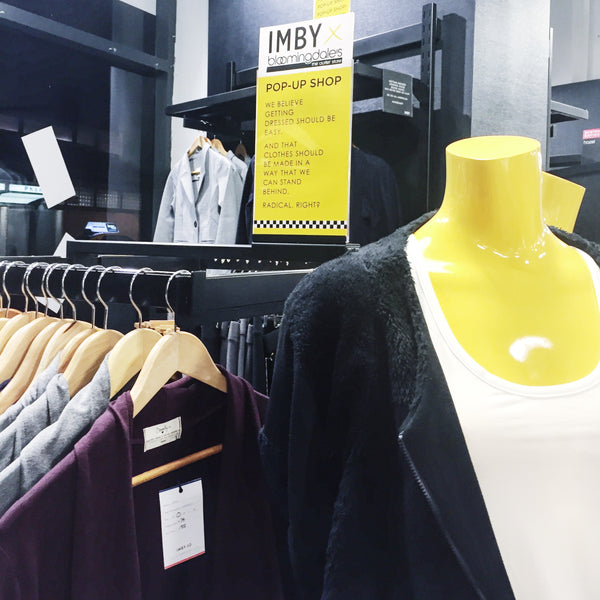For merchants who sell only online, the idea of selling in-person can be overwhelming. Successfully selling online requires merchants to learn a variety of new skills, but the potential benefits usually far outweigh the downsides.
Getting offline and physically in front of your customers is one strategy to help increase brand awareness, interact with people to gauge their interest in your product, and hopefully make a few sales.
There are also ways to sell offline that are relatively inexpensive. For example, you can create a mini pop-up shop in an existingbrick-and-mortar store. Also known as a "pop-in," this form of offline selling means you don't have to worry about renting a storefront for an extended period of time, furnishing it, and building up foot traffic. It also allows you to set up shop for a short period of time and feed off of an already existing physical location and customer base.
As a merchant myself, I’ve found that many brick-and-mortar businesses welcome pop-ins as it spreads the word about their establishment and brings in a new set of potential customers for them as well. I find it also works best to pop-in at an existing retail location or in a space where your demographic already hangs out.
For example, I sellactivewear, so I usually pop-in at fitness studios that already have a retail section and only during their peak class times. I have done this using various payment models — sometimes I pay a flat fee for the space for a predetermined timeframe or offer the host a percentage of my sales. By doing this, the hosting retailer is usually more inclined to also promote the event, and if it doesn't turn out exactly the way you had hoped, you're not losing money. In my experience, my most successful pop-ins at fitness studios have lead to new wholesale accounts.
But fitness studios are just one example of how sellers can collaborate on a pop-in. Read on for eight more examples of successfulpop-in shopsthat will help you decide if this offline sales model is right for your business.
1) Segara Swim @ Cuyana

LA-based and madeSegara Swimoffers refined swimwear that’s versatile. With two successful pop-in events atCuyana, — a minimalist retailer that swears by a 'lean closet', the brand has another one planned for this month.
When planning pop-in events, Segara Swim founder Eva Leung focuses on brand alignment.
"I think that making sure your brands are aligned — style, values, customer base, etc. — is important. If you're pitching a pop-in at a store that's all aboutsustainability and ethical productionbut you're a fast-fashion brand, you're not likely to resonate with their customer base. Cuyana's mission is fewer, better things, which aligns well with Segara's approach to responsible, local production. Their design style is minimal and modern, which also aligns well with Segara's design aesthetic."
Leung also keeps an eye out for retailers that carry complementary products and prefers to work with retailers who are willing toco-marketthe event.
“有突然出现的品牌和零售商推销the event will help spread the word. Sending out a newsletter to your mailing list and promoting the event on social is key," says Leung.

Pop-Up Shop Quickstart Guide
Thinking about hosting a Pop-Up Shop? This free guide includes 3 checklists that help frame what you're looking to accomplish through your Pop-Up Shop, different types of Pop-Up Shops, and design ideas to help get you started.
Get your Pop-Up Shop Quickstart Guide delivered right to your inbox.
Almost there: please enter your email below to gain instant access.
We'll also send you updates on new educational guides and success stories from the Shopify newsletter. We hate SPAM and promise to keep your email address safe.
2)Squish Marshmallows @ Union Square Holiday Market
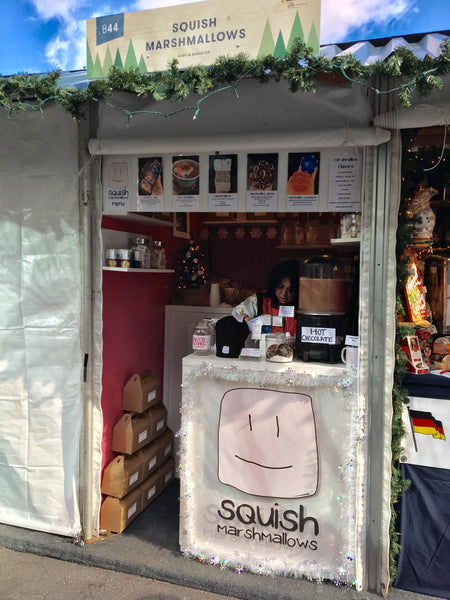
Vendy awards 2015 finalist for "Best Dessert,"Squish Marshmallowsmakes small-batch handcrafted marshmallows in New York City and ships nationwide.
Founder Katherine Sprung has had great success popping in at theUnion Square Holiday Marketin New York City.
"It's an amazing pop-up Holiday shopping experience right in the center of Union Square, the location definitely helps make it a high traffic area," says Sprung.
Offering homemade hot chocolate during the winter holiday gifting season was a huge help in luring in customers. Sprung's pop-in was also successful thanks to marketing on social media in partnership with the Union Square Market, who has a broader audience and wider reach.
Another key marketing tactic you shouldn’t forget isemail marketing, which can have anROI of 122% — more than four times higher than other marketing像社会我的工具dia, direct mail, and paid search.
While it was a successful event, next time Sprung plans to further strategize on her booth’s layout and storage to maximize the flow and opportunity to showcase her offering.
FURTHER READING:Learn how to turn foot traffic into sales withthese brilliant market booth ideas.
3) Tictail @ # LonnyLivingRoom


Tictailis a retail shop that supports emerging brands. Their marketplace is a one-stop destination for fashion, art, and home décor from small businesses from around the world. They currently havetwo physical locations: one in NYC and one in Stockholm, where they hold variousevents. You can evenstart a shopwith them to sell on tictail.com.
As a small business, finding partners with a larger audience and a broader reach can be beneficial in growing your customer base.
I asked Tictail PR AssociateRaleigh Norris, about their most recent successful pop-in called#LonnyLivingRoom, a collaboration between Tictail and Lonny Magazine.
"We partnered with San Francisco-based home decor outletLonny MagforNYCxDesignWeek to create the ultimate, West Coast-inspired living room in our store, Tictail Market. Featuring emerging artists, ceramicists, and designers from around the world, #LonnyLivingRoom was a true testament to how gorgeous a space can be when it’s made up of unique, diverse products created by small businesses," says Norris.
The event featured products from three Tictail designers and artists,Evan Crane,Sonia Laudet, andCelia Jacobs. Lonny’s editorial team handpicked each piece directly from the Tictail marketplace for a curated experience of their favorite Tictail finds.
The pop-in event was live for five days and saw the most success during their launch party. Open to the public, Tictail and Lonny spread the word by joining forces and marketing the event through social media, email, and Lonny’s website.
"Despite the fact that over 150 people were in attendance, the cozy vibes of the space and the unique stories behind every piece within it made it feel like the party was taking place in a good friend’s new apartment, not a storefront on the Lower East Side. And since the purpose behind any event that we host is to give our community the opportunity to better get to know the brands that sell on Tictail, we definitely considered this celebration of so many emerging designers and artists a success," Norris said.
4) Belle Force Activewear @ Xtend Tribeca
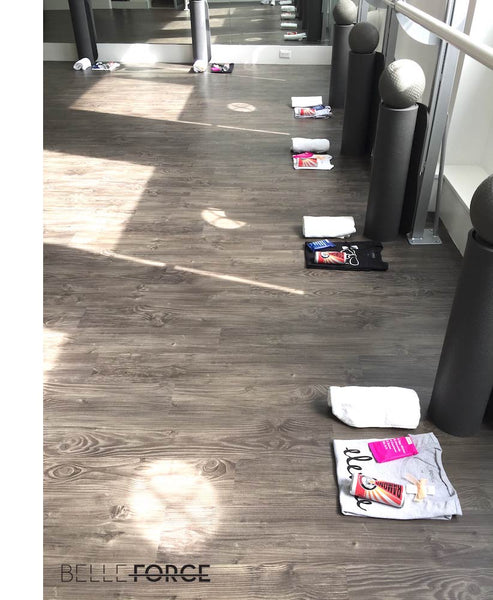
For many small, early-stage brands, includingBelle Force Activewear, pop-ins可以销售和世博会的巨大推动力ure. Belle Force's founder, Kelsey O'Connell, agrees that pop-ins are more accessible as a small business and in her experience, most places host for free or will take a small cut of the profits — forcing you to take on very little risk upfront.
O'Connell has had the most success partnering with boutique fitness studios, as they share the same target demographic and ultimately result in getting her product in front of the right customers.
"They instantly connect the brand with their following, clients and customer base, via marketing prior to the event and by foot traffic during the pop-in," says O'Connell.
It's also a win for the studio. They have the opportunity to share fresh, new products with their clients and Belle Force always markets events to their community, resulting in new studio clients.
"It's important to me that it's always mutually beneficial — really a win for the space that's hosting us. Sometimes I connect our networks to bring in collaborators that complement our event, including influencers, brand ambassadors, or food and drink sponsors to add another level of value to the pop-in," says O'Connell.
One of the brand’s past events was atXtend Tribeca. Belle Force popped in and hosted a barre class at the studio. Product was set up in their retail section, and they outfitted each attendee with a tank. As an incentive to keep clients lingering and mingling after class, O'Connell brought in snacks and drinks (complimentary from sponsors) to encourage socializing afterward.
5) StyleNMotion @ Home

Online clothing boutiqueStyleNMotionis a one-woman show run by founder Caitlin Nystrom. With a focus on layering, mixing and matching, and having fun with your wardrobe, items are hand-picked, styled, and shipped direct to customers.
Nystrom's most successful pop-in was at her Mother's house in Ohio.
"I brought the boutique to her and really made it a fun girls day. It was an open house — [people could] stop by, have a glass of wine, and get a new look for summer. Ladies could catch up and see old friends and make new friends," says Nystrom.
I like to call this the modern day Tupperware party, why not? What's great about an at home pop-in is that there is a certain level of trust, no one is really a "stranger" and it's much easier to break the ice, chat, and relieve the pressure of "selling." Plus, the venue is free!
You can also tap into a different customer base with a home-based party.
"She invited all different groups of women and really made it about shopping small. The friends and family factor definitely helped but everyone was encouraged to bring their ladies and make it a party!" says Nystrom
Nystrom's mission is to make shopping about the styling experience and supporting women in business.
6) Social Sunday @ We Are Women Owned in SoHo
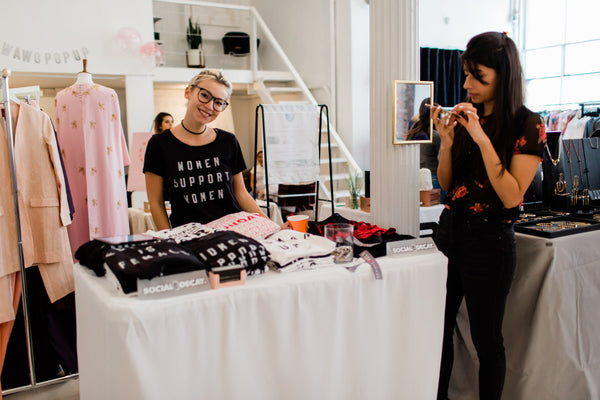
Made for the go-getter that lives for the balance between an active lifestyle and relaxing, self-care Sundays,Social Sundaycreated graphic clothing that’s hand-printed in Brooklyn, NY.
Last month, Social Sunday had a very successful pop-in in SoHo withWe Are Women Owned, a community, events, and service-based platform dedicated to connecting, uplifting, and empowering female entrepreneurs.
"It consisted only of women-owned business vendors and it was super inspiring. Everyone who was there to shop was all about girl power and supporting other women," says Ashley Laderer, Social Sunday’s Digital Marketing Coordinator.
Lucky for Social Sunday, this is essentially their target demographic, which made the event a perfect fit and allowed Social Sunday to connect directly with their market in-person.
"It was also great to hear their feedback on how much they love our graphics and quality of our tees. Plus, we acquired a lot of email addresses for our newsletter!" says Laderer.
Again, email marketing in this instance is important. It's your way to stay in touch with your customers and talk directly to them, tell them about new products, sales, and upcoming events.Ladereragrees.
"I believe it's equally important to collect emails and grow your potential customer base at a pop-in as it is to sell on the spot."
7) Leah Weinberg for Johnny Cupcakes @ Sugar Monster
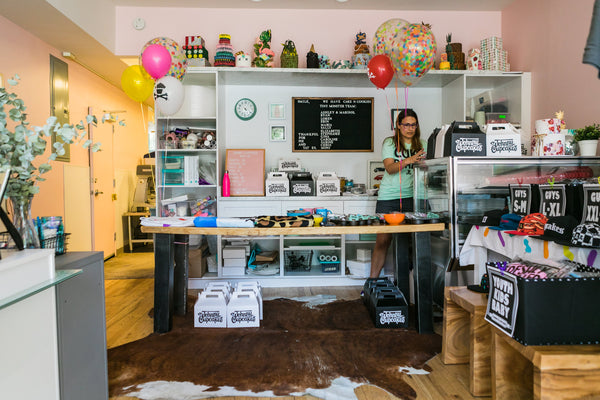
Leah Weinberg, founder ofColor Pop Events, is the official Cake Dealer forJohnny Cupcakes, the world's first T-shirt “bakery.” Weinberg plans events for the brand where she pops-in at an existing establishment, sells Johnny Cupcakes merchandise, and turns it into a party
"I hosted a pop-in shop for the Johnny Cupcakes brand at theSugar Monsterbakery in Brooklyn. The pop-in was open for three hours and I had a steady stream of customers for pretty much the entire time," says Weinberg.
According to Weinberg, there were two things in particular that made the event successful:
- The bakery space:Weinberg described it as a small but mighty space. The space was very well laid out withInstagram-worthy decor, like a neon "Girl Boss" sign in the window. The Johnny Cupcakes display consisted of a clothing rack, T-shirt bins, and accessories.
- Sugar Monster had actual cupcakes for sale:"I gave away cupcakes to the first 25 people that day. There's this eternal confusion as to why a company called Johnny Cupcakes doesn't sell cupcakes (which they actually do but only on April Fool's Day), so it was fun to be able to offer people cupcakes in addition to super cool t-shirts and merch," Weinberg said.
Giveawaysare a great way to get customers in the door and also start a conversation between you and your potential customer.
8) IMBY + Sara Weinreb
IMBYfounderSara Weinrebhosted a pop-in two months after her launch atBloomingdale’s. IMBY is an online retailer that lives by the motto "less is more". Weinreb believes we should declutter our lives, both physically and mentally, to make room for the things we really care about.
"I really used the experience as a prototype — an opportunity to get my brand in front of a ton of people and get feedback on the clothing, the price point, and understand what customers were looking for," says Weinreb.
You can only do so much online (especially as a small business). Getting face-to-face with your customers and hearing their feedback is sometimes even more important than scoring a sale.
当然“销售+,但有用的feedback I got was even more important,” Weinreb said. “I confirmed my assumptions that a targeted approach to people who care about consciously made clothes was important for my brand. The ‘masses’ that came through Bloomingdale’s were not necessarily looking for a made-in-USA, organic cotton T-shirt. They were looking for designer names."
Using this pop-in as a "test" helped Weinreb identify who was most interested in her product and understand who was not interested. Her advice, "Prototype and test ideas out in different settings. Look for low risk, low-cost ways to do this, so you can gain valuable feedback before going full throttle on one idea or market."
Moving Forward With a Pop-In Shop
Now that you have a deeper understanding of "pop-in" shops, you can use these examples to plan and execute your next event. There really are no rules, so get creative, have fun with it, and take advantage of meeting and learning from your customers in-person.



